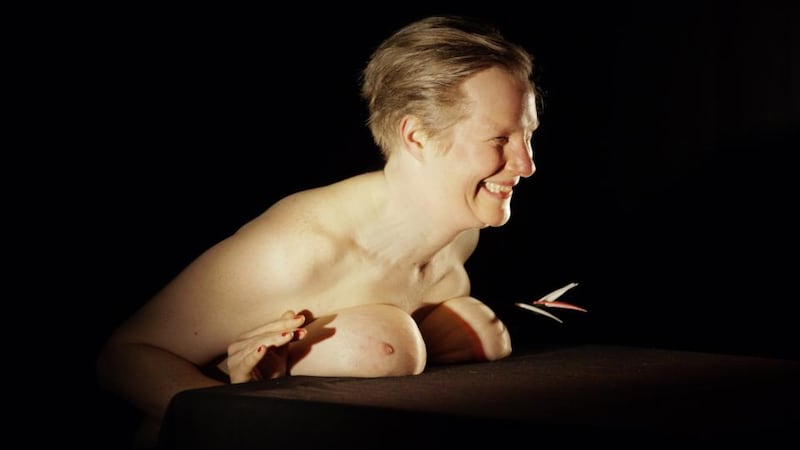Antonia Baehr is a performer, curator, producer, and writer. But is she a choreographer? "Hmm, good question," she says. "For many years I didn't put a label on my work. But I need to be able to say something when the taxi driver asks me what I do. So these days I do consider myself a choreographer – but in drag. Not gender drag, but professional drag."
The German artist’s work could be seen through any number of prisms, such as live art or performance art, but her physical aesthetic probably lies most easily in choreography. Albeit in drag.
Abecedarium Bestiarium, her latest work, which is showing at Project Arts Centre tonight and tomorrow, is a good example of a performance dressed up as choreography. Sometimes Baehr moves, sometimes she utters gibberish, sometimes she presents slides on a projector, but movement always takes precedence over concept. The show is subtitled "Portraits of affinities in animal metaphors", and each section was created by a friend, invited by Baehr to choose an extinct animal as a metaphor of their friendship. The short sections create an animal alphabet – D for dodo, T for Tasmanian tiger and so on – and are varied in form and execution.

“The idea was not to represent the animals, just to use them as a metaphor,” she says. Extinct species fascinate her because they are largely imagined, with some acquiring mythical status. But they can also have political undertones, since the reason for extinction is often linked to colonialism. Human intervention is almost always a contributory factor, as in the case of the baiji, or Yangtze river dolphin, whose demise has come from a combination of damming and overfishing.
Animals have appeared throughout her work since the 1990s and, having grown up in the countryside, she is keenly aware of the relationship between animal and human, and of the animal that resides in the human spirit.
Unconventional methods
In creating Abecedarium Bestiarium she eschewed the more traditional method of dance collaboration, where a choreographer sets movement in a dance studio. Instead, Baehr invited a number of friends to create dance scores. First, she sent a letter of invitation describing the details of the project. Some people started to work straight away, while others met and talked with her some more, but Baehr wanted to limit hands-on collaboration.
“It’s like a musician who commissions a composer to write a score. And I really prefer to work in this way, maybe because I like to think a lot. In the typical studio set-up the performer has to react on the spot to the choreographer’s ideas. With a score, you can think and reflect on the ideas before constructing the material.”
Many of these friends have other roles in Baehr’s projects, whether as curators, performers or creators, and these fluent relationships are indicative of Berlin’s art scene.
“When I came to Berlin in the 1990s, there were lots of artists arriving and squatting in old buildings. Almost everybody seemed to have a bar or space where they would produce and create work. Artists were always either hosting or being hosted.”
This culture of openness meant traditionally antagonistic battles – producer versus creator – were non-existent, and the arts basked in aesthetic freedom. She might have arrived in Berlin at a time of great possibility, but things weren’t the same when she moved to the US to pursue a master’s in performance at the Art Institute of Chicago. “It was unique in offering performance within an arts school,” she says. “Not just performance art or theatre, but other forms of performance, like animation.”
However, the Chicago scene had just been gutted by the death from Aids of performance artist Lawrence Steger, but more significantly by the collateral damage in the so-called culture wars. Chicago-based performance artist Karen Finley had her grant vetoed after her work was described as "indecent", and local venues sympathetic to performance art suffered. Baehr was ultimately drawn back to the free spirit of Berlin.
Changing Berlin
But the city is changing. The derelict semi-collapsed buildings that were squatted after the fall of the Berlin Wall have been replaced by gleaming glass and concrete. The highest-profile art squat, Tacheles, closed last year, its reported €250 million valuation too much for its owners to ignore any longer. A large police presence on the day of the eviction was met with futile petitions and a despondent violence-free ejection.
“Things are changing quickly, but there is still a lot of resistance,” she says. “The squatting movement is still strong, so there are still places to be found in the city.”
Baehr's work has increasingly taken her away from Berlin. From 2006 until 2008 she was associated artist in residence at Les Laboratoires d'Aubervilliers in France and earlier this year the Beursschouwburg in Brussels presented a three-month programme of performances and an exhibition entitled Make Up: At Antonia Baehr and Werner Hirsch's Table. She is looking forward to coming to Dublin, not least to be able to confidently tell the city's taxi drivers that she's a choreographer. In drag.
Abecedarium Bestiarium is at Project Arts Centre tonight and tomorrow at 8pm. There is an introductory talk by Melanie Suchy at 7pm tonight











